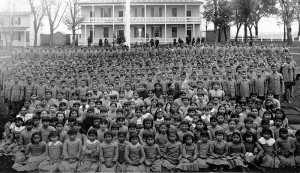Assimilation through Indian Boarding Schools
by Amanda McAllister, J.D. and Taylor Krawczewski
In the 1870’s, the United States began a process of assimilation of Native children through federal Indian boarding school policies. The goal of the boarding schools was to “civilize” Native children by erasing their Indian identity, which was considered “savagery,” and to assimilate them into Euro-American ways of life. This resulted in removing children from their homes, separating them from their families, forbidding them to speak their language and practice their culture, and forcing them to practice Christianity. The children were even given new Euro-American names and forced to cut their hair, which is a symbol of pride for many Native peoples.
Captain Richard Henry Pratt, a Civil War veteran, created the model for “civilizing” American Indians through education. His infamous quote regarding the philosophy of the boarding schools was to “kill the Indian, save theman.”[1] Pratt opened the first Indian boarding school named Carlisle Indian Industrial School. He based his program on an experiment teaching 72 Native prisoners in St. Augustine, Florida, who had been fighting against the US army. He taught them English, working trades, and converted them to Christianity. The United States began opening boarding schools across the country based on his work.
Children were often forcibly removed by armed police. Others were sent to the boarding schools because public schools were closed to Natives, so federal school was the only option.[2] Many were intentionally sent long distances from the reservation so that the “corrupting” influence of their families and tribal life did not interrupt the assimilation process. John B. Riley, an Indian boarding school superintendent wrote in an 1886 report to the Commission of Indian Affairs, “Only by complete isolation of the Indian child from his savage antecedents can he be satisfactorily educated…”[3]
The living conditions in many boarding schools were harsh. Outbreaks of diseases such as tuberculosis, measles, and trachoma were very common and served as significant threats to the students.[4] Hundreds of children died under these conditions. At Carlisle alone, there are almost 200 children buried in the school’s cemetery. There are reports of students being abused, including being malnourished and forced to do heavy labor. In 1928, the Problem of Indian Administration Report was created after a federal investigation into the outcome of government policies towards American Indians. The report found that children were malnourished, overworked, harshly punished, and poorly educated.
The school curriculums focused on gendered trades, such as housekeeping for girls and carpentry for boys, yet some schools didn’t even teach basic concepts in math or English.[5] There was often a military-style regimentation of
classes and activities. Children were strictly monitored and often punished for speaking in their language or practicing their culture. Punishments usually consisted of confinement, deprivation of privileges, and threat of corporal discipline. Many were the victims of beatings and sexual abuse by school officials.
The widespread abuse dealt blows to the traditional social structure of Native communities. “Before colonization, Native women enjoyed high status, and violence against women, children and elders was virtually non-existent. However, now sexual abuse and violence have reached epidemic proportions in Native communities, along with alcoholism and suicide.”[6] By the end of the 1990s, the sexual assault rate among Native Americans was three-and-a-half times higher than any other ethnic group in the U.S; alcoholism is six times higher than the national average. “Researchers are just beginning to establish quantitative links between these epidemic rates and the legacy of the boarding schools.”[7]
In 1969, a Senate report known as the Kennedy Report declared Indian education to be “a national tragedy.”[8] Boarding schools have been characterized as institutions of “outright genocide on the grounds that the mortality rate (from disease) within boarding schools was very high and that boarding schools took children from Native groups and in this way prevented births within them.”[9] The US boarding school policies contributed to the destruction of cultures, languages, and continuing problems facing Native communities today as a result of the historical trauma.
[1] Bear, Charla. “American Indian Boarding Schools Haunt Many,” Minnesota Public Radio, 12 May 2008. Web. 31 Oct. 2015.
[2] Indian Boarding Schools.” PBS: Indian Country Diaries. PBS. Sept. 2006. Web. 29 Oct. 2015.
[3] Bear. “American Indian Boarding Schools Haunt Many,” 12 May 2008.
[4] “History and Culture: Boarding Schools.” American Indian Relief Council. Web. 7 Nov. 2015.
[5] Bear, Charla. “American Indian Boarding Schools Haunt Many,” Minnesota Public Radio, 12 May 2008. Web. 31 Oct. 2015.
[6] Smith, Andrea. “Soul Wound: The Legacy of Native American Schools. Amnesty International. 26 Mar. 2007. Web. 9 Nov. 2015.
[7] Ibid.
[8] Bear. “American Indian Boarding Schools Haunt Many,” 12 May 2008.
[9] Ostler, Jeffrey. “Genocide and American Indian History.” American History. Mar. 2015. Web. 29 Oct. 2015.




